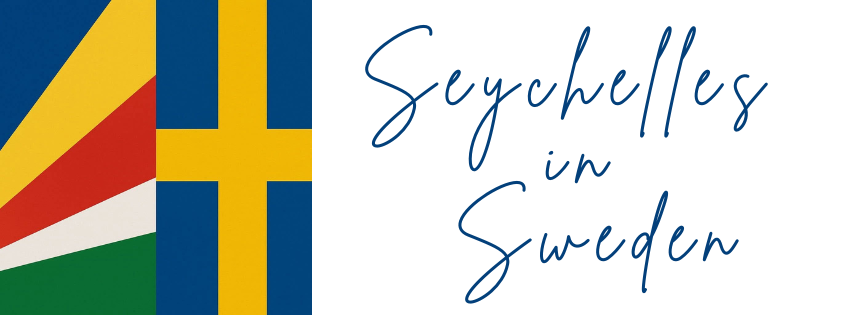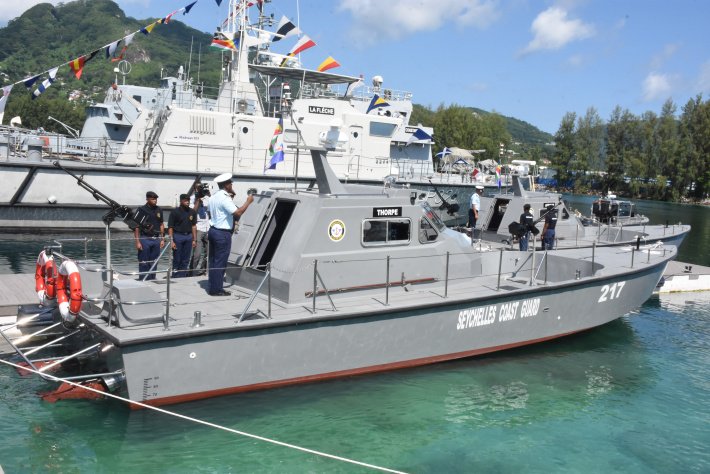Joint Approaches to Counter Illegal Fishing, Maritime Surveillance, and Regional Safety
By Salim C. Mathieu
Seychelles’ strategic location in the Indian Ocean gives it a unique advantage and responsibility: ensuring maritime security across vast waters rich in fisheries, biodiversity, and shipping routes. At the same time, threats such as illegal, unreported, and unregulated (IUU) fishing, piracy, and smuggling challenge national security and economic stability. Sweden, a strong maritime nation with advanced coast guard capabilities, satellite monitoring, and experience in regional cooperation, offers a valuable partnership opportunity for Seychelles to enhance its maritime security frameworks.
1. Maritime Security Context in Seychelles
Seychelles’ Exclusive Economic Zone (EEZ) covers over 1.3 million km², one of the largest in Africa. The waters are rich in tuna and other high-value species, making fisheries both a critical revenue source and a target for illegal activities. Reports from the Indian Ocean Tuna Commission (IOTC) and the Seychelles Coast Guard highlight:
Significant IUU fishing by foreign vessels, particularly in tuna fisheries.
Limited capacity for real-time monitoring of remote areas.
Occasional piracy threats along regional shipping routes.
Maritime security is therefore not just about law enforcement; it is a cornerstone for economic sustainability, blue economy development, and environmental protection. Strengthening surveillance, enforcement, and regional cooperation is essential.
2. Sweden’s Maritime Security Expertise
Sweden brings decades of experience in both national and international maritime security. Its Swedish Coast Guard and Swedish Transport Agency provide integrated monitoring, law enforcement, and environmental protection across territorial waters. Key capabilities include:
Satellite-based vessel tracking and automatic identification systems (AIS).
Integrated command and control centers for rapid response.
International cooperation models with neighboring countries for joint patrols and information sharing.
Research-driven policy and legal frameworks to ensure compliance with international maritime law and sustainable fisheries management.
Sweden has successfully implemented these systems in the Baltic Sea, balancing environmental protection, fisheries enforcement, and regional cooperation — a model that can be adapted to Seychelles’ tropical, island context.
3. Potential Cooperation Areas
a) Illegal, Unreported, and Unregulated (IUU) Fishing
IUU fishing undermines Seychelles’ fisheries revenue and conservation goals. Sweden’s expertise can assist in:
Capacity building for Seychelles Coast Guard and fisheries enforcement agencies.
Advanced monitoring using AIS, satellite imagery, and drone surveillance.
Legal and policy guidance to prosecute violations in line with international law.
Data-sharing protocols with regional bodies such as the South West Indian Ocean Fisheries Commission (SWIOFC).
Joint operations, training, and intelligence sharing with Swedish experts can improve detection, reduce illegal catch, and enhance sustainable management of fish stocks.
b) Maritime Surveillance Technology
Effective surveillance is the backbone of maritime security. Swedish technology solutions suitable for Seychelles include:
Integrated maritime surveillance systems combining radar, satellite, and vessel monitoring.
Coastal and offshore sensor networks to detect unauthorized entries.
Mobile and unmanned systems for patrolling remote islands and reefs.
Data analytics for predictive risk assessment, allowing resource allocation to high-risk areas.
A phased implementation — starting with pilot systems around Mahé and Praslin — can demonstrate feasibility and effectiveness before scaling to outer islands.
c) Joint Training and Capacity Development
Security operations are only as effective as the personnel executing them. Swedish support can include:
Coast Guard training programs, focusing on surveillance operations, boarding procedures, and emergency response.
Simulation and scenario-based exercises to enhance decision-making in maritime incidents.
Legal and investigative training for fisheries enforcement and maritime law.
Exchange programs allowing Seychellois officers to observe Swedish maritime operations, and Swedish experts to learn about Indian Ocean challenges.
This human capital development ensures long-term sustainability of maritime security efforts.
d) Regional Coordination
Maritime security is inherently regional. Seychelles’ partnerships with Comoros, Mauritius, Madagascar, and Kenya can be strengthened with Swedish support in:
Information sharing protocols to track vessels across EEZs.
Joint patrol exercises and interoperability standards.
Early-warning systems for piracy, smuggling, or environmental incidents.
Participation in regional maritime forums with Swedish advisory support.
Regional cooperation improves efficiency, reduces operational duplication, and enhances diplomatic relationships across the Indian Ocean.
4. Operational and Strategic Benefits
For Seychelles:
Reduced economic losses from IUU fishing.
Enhanced maritime domain awareness across a vast EEZ.
Improved safety for commercial and passenger vessels.
Strengthened human resource skills for long-term maritime security.
For Sweden:
Expansion of Swedish maritime technology and training programs in a strategic region.
Strengthened diplomatic and economic relations with Seychelles and the Indian Ocean region.
Practical research opportunities in tropical maritime operations and regional cooperation frameworks.
5. Implementation Roadmap
Assessment Phase (2025): Conduct a joint audit of Seychelles’ maritime surveillance infrastructure and identify capability gaps.
Pilot Program (2026): Deploy Swedish surveillance technology on a select EEZ sector and conduct joint training exercises.
Capacity Building (2026‑2027): Run exchange programs, workshops, and simulations to enhance skills and procedural knowledge.
Regional Coordination (2027‑2028): Establish information sharing agreements, conduct joint patrols with regional partners, and integrate technology systems.
Evaluation and Scale-Up (2028‑2030): Measure impact, refine systems, expand to outer islands, and explore integration with fisheries research and conservation initiatives.
6. Challenges and Mitigation
High operational costs: Mitigate via blended finance and donor-supported technology acquisition.
Technical adaptation to tropical environments: Pilot testing and localized adaptation with Swedish engineering support.
Coordination across agencies and countries: Establish a clear governance structure with defined roles, protocols, and communication channels.
Sustainability of expertise: Develop in-country trainers and maintain ongoing Swedish advisory support for knowledge transfer.
7. Synergies with Other Partnerships
Maritime security cooperation complements other areas of Seychelles–Sweden collaboration:
Blue economy development: Secure fishing grounds support sustainable fisheries and aquaculture.
Climate adaptation: Monitoring and response systems help detect and mitigate environmental threats such as coral bleaching or oil spills.
Tourism safety: Ensuring safe maritime transport enhances Seychelles’ reputation as a safe and responsible destination.
By integrating maritime security with broader economic and environmental strategies, Seychelles and Sweden create a holistic partnership with multiple benefits.
8. Conclusion
Seychelles’ maritime domain is vast, valuable, and vulnerable. Swedish cooperation offers proven technology, training, and policy expertise to enhance security, protect fisheries, and ensure safe and sustainable maritime operations. Through joint programs in surveillance, IUU enforcement, and regional coordination, Seychelles can strengthen its blue economy, secure livelihoods, and maintain its international reputation as a responsible maritime state.
Investing in maritime security is not simply a defensive measure — it is an investment in economic resilience, environmental protection, and long-term sustainable development. With Sweden as a partner, Seychelles can set a regional example for small island states combining technology, human capacity, and international cooperation to safeguard the ocean.

